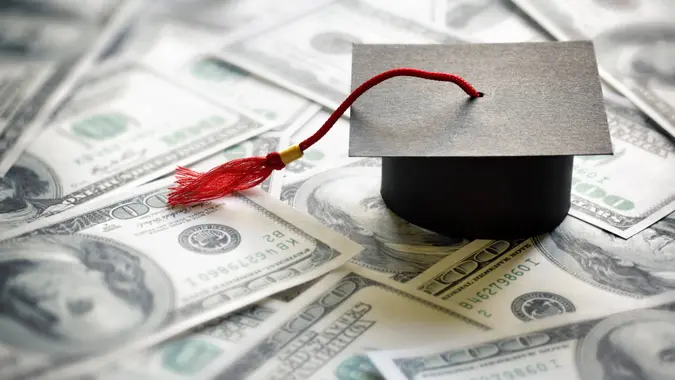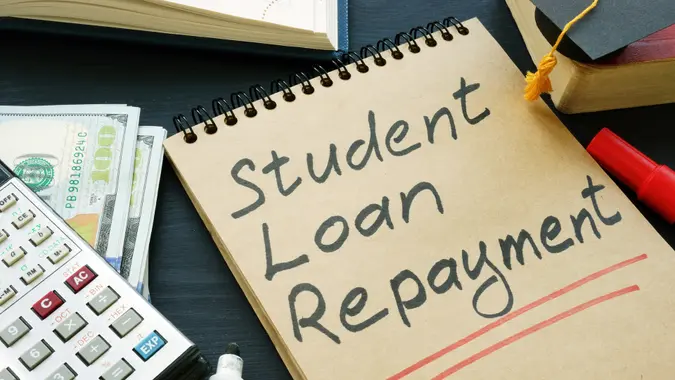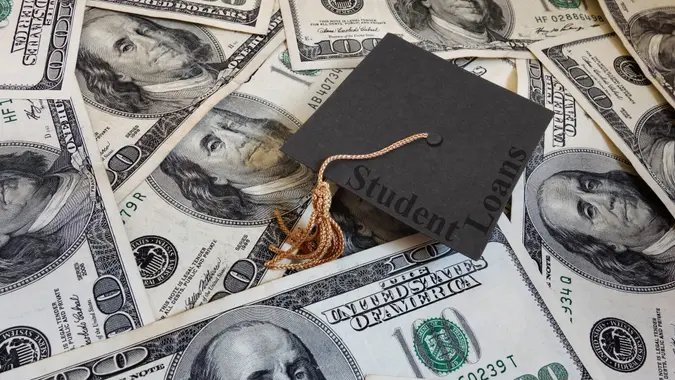Banks and Student Loans: 9 Things You Need To Know

Commitment to Our Readers
GOBankingRates' editorial team is committed to bringing you unbiased reviews and information. We use data-driven methodologies to evaluate financial products and services - our reviews and ratings are not influenced by advertisers. You can read more about our editorial guidelines and our products and services review methodology.

20 Years
Helping You Live Richer

Reviewed
by Experts

Trusted by
Millions of Readers
When you think about getting a student loan, you might not consider going through a bank. As of 2024, only 8.84% of student loan debt belongs to private lenders, while the rest is federal. However, federal aid doesn’t always cover enough to put college within reach, and not everyone is eligible.
Whether you’ve already secured a loan or you’re considering applying, going through a bank can help put college within reach. Here’s what you need to know about what’s available, how to apply and what the application and repayment timelines look like.
Funds Are Available for College and Beyond
There are private student loans available for almost every level of postsecondary education. Banks offer loans for undergraduate, graduate and postgraduate students. You can even get private loans for certain career training programs.
You Can Borrow Up to the Cost of Attendance
Federal student loans limit the amount you can borrow. Limits range from $5,500 yearly for a first-year financially dependent student to $20,500 for graduate and professional students.
Private student loans don’t have those fixed maximums. You can typically borrow up to your institution’s cost of attendance minus other loans and scholarships. With this higher limit, bank loans can bridge the gap between aid offers and college costs.
Federal Aid Happens First
According to Citizens Bank, most students should start by filling out the Free Application for Federal Student Aid (FAFSA). Federal student loans usually have lower interest rates than private loans and may offer more options for repayment. Loan forgiveness and income-driven repayment are generally only available for federal loans.
It’s best to wait to apply for private aid until you receive your total financial aid package from your school. Assuming you filled out the FAFSA, that award will include any federal loans, scholarships and grants you’ve received. Use this information to determine how much you need to borrow, and plan to apply no later than two months before tuition is due.
You’ll Need Financial Documents
Applying for a private student loan is much like a personal loan. The bank wants to know if you can afford the payments, so you’ll need to provide evidence of your finances. Plan to bring as much of the following as you have:
- Personal ID and Social Security number
- Income documentation, including recent paystubs
- Employer name and contact information
- Monthly housing payment
- School name and expected graduation date
- Loan amount and term
- Personal reference
If you don’t have this kind of documentation, you can get a cosigner to apply for the loan with you.
Cosigners May Help With Approval
Private student loans require borrowers to have a qualifying credit history, meaning most traditional undergraduates will need a cosigner. A cosigner puts their name on a loan agreement alongside the primary applicant and agrees to take over payments if the applicant defaults. Parents and guardians are the most common cosigners, but any qualifying borrower can take on the responsibility.
Rates Vary by Lender and Borrower
While federal student loans offer the same interest rates to all students, bank loans customize rates based on the borrower’s qualifications. The lender will also examine the credit history and income of your cosigner, if you have one.
Interest rates for student loans may be fixed or variable. A fixed rate stays the same over the life of the loan, no matter what happens to market interest rates overall. A variable interest rate changes with market trends, so your payments may go up or down depending on whether overall interest rates rise or fall.
As with other private loans, your interest rate will depend on your and your cosigner’s qualifications. Shop around for the best loan offer from a reputable, trustworthy lender. Consider interest rates and any fees, such as an origination fee or early repayment fee.
Start Repaying Now or Later
Banks offer three basic types of student loan repayment, each with pros and cons.
Deferred Payment
With deferred payment, you start making payments only six months after you leave school or reduce your enrollment. This option will lower your expenses while you’re a student, but your loan will continue to accrue interest.
This interest will become part of your balance, and the higher the balance, the more interest the loan will generate.
For example, if you borrow $10,000 at 10% interest, you’ll owe an additional $1,000 by the end of the year. Your loan balance will now be $11,000. If you hold that loan for another year, it will accrue another $1,100 in interest. Now, you’ll owe $12,100 plus any other loans you take out for that second year.
Interest-Only Payment
Interest-only payment means you can pay accumulating interest while in school and begin paying off the principal after you graduate, drop out or reduce enrollment to half-time or less.
With this option, your balance doesn’t grow with interest-only payments because you pay interest as you go. Some lenders even offer lower interest rates for students who choose this type of plan.
Immediate Payment
Under immediate repayment plans, you can start making standard monthly payments, including interest and principal, while in school. These plans are even more cost-efficient because you start paying off the balance immediately. A lower balance means you pay less interest over the life of the loan.
Multiyear Approval Is Available
Some banks offer a multiyear approval process, which qualifies you to borrow a certain amount for every year of your education.
As you shop around for loan options, check with banks to learn how they handle applications for your second year and beyond. If you’re reasonably confident that you’ll need additional aid for future years, applying only once may save you time and hassle.
Read the Fine Print
No matter what kind of loan you apply for, read the terms and conditions carefully. You want to know about potential fees, including late fees or prepayment penalties. If you hope to repay your student loans early, you’ll want a fee-free option for prepayment.
Always research your lender’s reputation. Check review sites to learn about other students’ experiences. If you’ve already taken a loan and are unhappy with the terms, refinancing may be possible. With some legwork and the right lender, you can find the bank loan that works for your student borrowing needs.
More From GOBankingRates
 Written by
Written by  Edited by
Edited by 
























